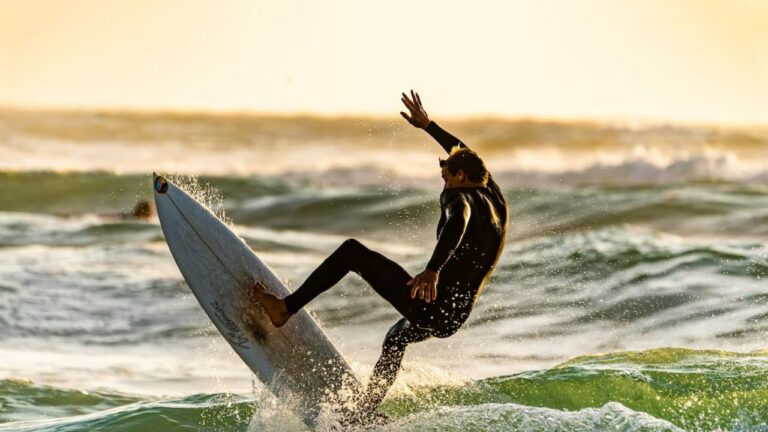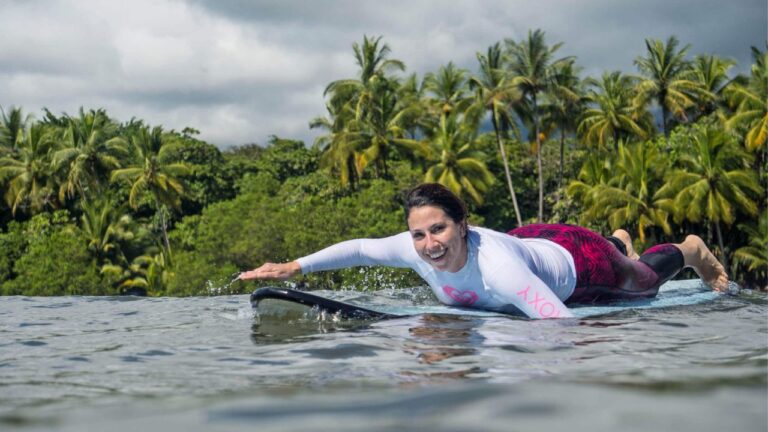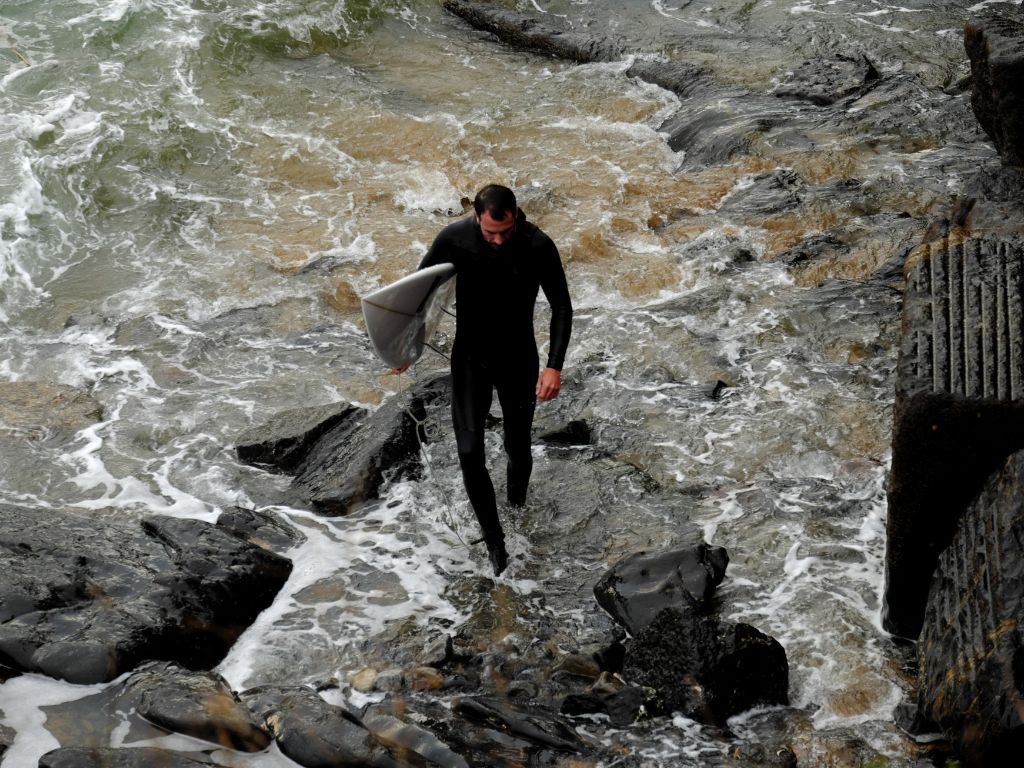Welcome to the exciting world of professional surfing in the United States! Becoming a professional surfer is a journey that requires dedication, passion, and a deep love for the ocean.
One of the most exciting aspects of pursuing this career is the potential opportunities it offers. As a pro surfer, you get to travel to breathtaking locations, participate in prestigious events, and share the stoke with fellow surfers from around the globe.
So, whether you’re a novice surfer dreaming of turning pro or an experienced rider looking to take your skills to the next level, this guide will serve as your compass for the journey ahead.
Get ready to paddle out!
Step 1: Understand the pro surfing landscape.
The World Surf League (WSL) is the premier governing body for professional surfing worldwide. It hosts the most prestigious events, sets the standards for competition, and crowns the world champions.
What are these grand events you could participate in? At the top of the hierarchy is the Championship Tour (CT), which consists of the world’s best surfers competing at iconic surf breaks around the globe.
The CT events are highly competitive and attract a massive following of both fans and sponsors. The WSL also operates the Qualifying Series (QS), a pathway for surfers aspiring to qualify for the CT.
After that, you have regional surfing associations and local contests. These competitions help surfers gain experience, build confidence, and establish themselves within their local surfing communities.
Regarding rankings, professional surfers are assessed based on their performance in events and their accumulation of points. The rankings determine their positioning within their respective circuits and measure their competitive standing.
By comprehending the structure of professional surfing events and rankings in your area, you can navigate the competitive landscape and set your sights on achieving that “pro surfer” tag.
Step 2: Polish your skills and techniques to the most.
Becoming a pro surfer requires more than just a passion for riding waves. Whether you’re a beginner or have some experience, improving your skills and techniques is crucial for success in competitive surfing.

1. Master the fundamentals.
Before diving into advanced maneuvers and tricks, it’s crucial to have a solid foundation of basic surfing skills. Fundamental skills such as paddling, popping up, balancing, turning, and reading waves are building blocks of your foundation.
Paddling: Focus on proper body positioning, paddle technique, and arm strength to improve speed and endurance.
Popping Up: Practice your pop-up technique to ensure a fast and fluid motion.
Balance: Engage your core muscles and practice balance exercises on land to improve your stability in the water.
Turning: Learn how to perform basic turns, such as bottom turns and top turns to generate speed and control your board.
Reading Waves: Learn to identify the peak, understand wave sections, and anticipate the best line to ride.
2. Types of Waves and Conditions
The United States offers diverse surf spots, each with its own characteristics and wave types. From powerful beach breaks to long point breaks, understanding the different types of waves and conditions will help you adapt your surfing approach and choose the right equipment.
Moreover, it’s important to understand how wave conditions can impact your surfing experience. Wave size, tide, wind direction, and swell direction affect wave quality and rideability.
Pro Tip: Study the lineup and observe more experienced surfers to understand how they position themselves for the best waves.
Step 3: Focus on physical fitness and conditioning.

It’s no surprise to anyone that pro surfing athletes need a well-rounded physical fitness level. Surfing engages the entire body, from paddling and popping up on the board to maneuvering and maintaining balance on the waves.
To improve your physical fitness for surfing, incorporate the following training routines and exercises into your regimen:
a. Strength Training: Focus on exercises that target the upper body, core, and leg muscles. Push-ups, pull-ups, planks, squats, and lunges effectively build strength.
b. Cardiovascular Conditioning: Engage in cardiovascular exercises such as running, swimming, or cycling to improve cardiovascular endurance, which will help you paddle for longer durations.
c. Flexibility and Mobility: Incorporate stretching and yoga into your routine to improve flexibility, mobility, and muscle recovery.
d. Balance and Stability: Include exercises that enhance balance and stability, such as yoga poses, stability ball exercises, and balance board training.
e. Agility Drills: Perform agility drills like ladder exercises, cone drills, and quick-footwork exercises to enhance coordination, reaction time, and foot speed.
f. Water-Based Conditioning: Besides land-based exercises, simulate surfing movements in the water to enhance your surfing-specific conditioning.
g. Cross-Training: Engage in activities that complement surfing, such as skateboarding, snowboarding, or balance training on an Indo board.
i. Injury Prevention Exercises: Include exercises targeting specific muscle groups prone to injuries in surfing, such as the shoulders, lower back, and knees.
Remember to tailor your training routine to your needs and gradually increase intensity and duration as your fitness improves. It’s also important to listen to your body and allow for proper rest and recovery to avoid overtraining and injuries.
Step 4: Be mentally prepared and keep yourself motivated.

Surfing is a physically demanding sport and requires a strong mental game. Staying calm, focused, and resilient in challenging and high-pressure situations is crucial for success as a professional surfer.
1. Developing Mental Resilience
a. Embracing Challenges: Adopt a growth mindset and view challenges as opportunities for growth and learning. Embrace failures and setbacks as stepping stones toward improvement.
b. Managing Stress: Develop effective stress-management techniques, such as deep breathing exercises, meditation, and visualization.
c. Positive Self-Talk: Use positive self-talk to build confidence and overcome self-doubt.
2. Handling Pressure
a. Focus on the Present: You can perform at your best without distractions by staying in the present.
b. Routines and Rituals: Develop pre-competition routines and rituals that help you mentally prepare and create a sense of familiarity and comfort.
c. Mindfulness: Practice mindfulness to cultivate awareness and non-judgmental observation of your thoughts and emotions.
3. Visualization and Goal Setting
Visualization is a powerful tool used by many professional athletes, including surfers. By mentally rehearsing successful performances and envisioning yourself achieving your goals, you can enhance your performance and build confidence.
a. Create Detailed Visualizations: Imagine yourself riding perfect waves, executing flawless maneuvers, and achieving your desired outcomes. Visualize these scenarios’ sensations, emotions, and details to make your visualizations more vivid and impactful.
b. Use Affirmations: Alongside visualization, use positive affirmations to reinforce your goals and boost confidence.
c. Write Down Goals: Document your goals and regularly review them to stay focused and motivated.
4. Seeking Professional Support
In some cases, seeking professional support can be beneficial for enhancing your mental game. Sports psychologists or mental performance coaches specialize in working with athletes to optimize their mindset and performance.
5. Learning from Experience
As you progress in your surfing career, remember that experience is a valuable teacher. Each competition, practice session, and wave-ridden offer an opportunity to learn and grow mentally.
Reflect on your performances, identify areas for improvement, and apply the lessons learned to future endeavors.
Step 5: Build a dazzling competitive profile.

Local, regional, and national competitions provide valuable opportunities to showcase your skills, gain experience, and receive feedback from judges.
a. Participate in the events: By consistently participating in these events, you can identify areas for improvement and get noticed by industry professionals.
b. Develop an Online Presence: Create a professional website or portfolio showcasing your surfing journey, videos of your best performances, and engaging content demonstrating your passion for the sport.
c. Engage on Social Media: Use social media platforms to connect with the surfing community, share your progress, and engage with fans and sponsors.
d. Network with Industry Professionals: Attend surfing events, join surfing clubs or organizations, and network with industry professionals, including surfers, coaches, judges, and sponsors.
Remember, building a competitive profile takes time and dedication. Consistency, perseverance, and a strong work ethic are key.
Step 6: Get a sponsor to support your training & career.

In professional surfing, networking and sponsorship are crucial elements that can help you advance your career and open doors to exciting opportunities. If you’re experienced, you already know that the cost of surfing is quite high.
a. Financial Support: Surfing at a professional level requires significant financial resources. You must cover travel, accommodation, competition entry fees, equipment, and training costs.
b. Professional Development: These enable you to access professional training programs, coaching, and mentorship opportunities. Sponsors often have connections within the surfing industry and can facilitate introductions to experienced coaches and trainers who can help improve the surfer’s skills and performance.
c. Access to Resources and Equipment: Sponsors often provide surfers with access to high-quality equipment, including surfboards, wetsuits, and accessories.
d. Professional Networking: Sponsors can provide surfers with valuable networking opportunities within the surfing industry. They often have connections to influential individuals, event organizers, and industry insiders who can help surfers navigate the competitive landscape and gain exposure.
1. Creating a Sponsorship Package
Securing sponsorships is an important aspect of professional surfing. Here are some tips for creating a compelling sponsorship package:
a. Highlight Your Achievements: Showcase your surfing accomplishments, competition results, and notable performances. Include photos and videos that demonstrate your skills, style, and potential.
b. Outline Your Goals: Clearly articulate your short-term and long-term goals as a professional surfer. Explain how a sponsorship would help you achieve these goals and contribute to your development as an athlete.
c. Showcase Your Brand Value: Highlight your brand and unique selling points. Explain how you align with the values and image of potential sponsors and how you can promote their brand effectively.
d. Offer Exposure Opportunities: Outline the platforms and channels where you can provide exposure for sponsors.
2. Approaching Potential Sponsors
Approaching potential sponsors can be nerve-wracking, but with the right approach, you can increase your chances of securing sponsorship with the right approach.
a. Research Potential Sponsors: Conduct thorough research on potential sponsors to understand their brand, products, and target audience. This knowledge will enable you to tailor your approach and demonstrate your alignment with their values and objectives.
b. Make a Personal Connection: Find ways to establish a personal connection with potential sponsors. Look for common interests, shared values, or mutual acquaintances that can help initiate a conversation and build rapport.
c. Craft a Compelling Pitch: Develop a well-crafted pitch highlighting your unique qualities, achievements, and the benefits of partnering with you. Clearly communicate how you can add value to their brand and contribute to their marketing efforts.
d. Be Professional and Persistent: Approach potential sponsors professionally, showcasing your dedication, professionalism, and commitment to your surfing career. Follow up on your initial contact and be persistent while respecting their time and decisions.
e. Build Relationships: Sponsorship is more than just a financial transaction. It’s about building mutually beneficial relationships. Nurture your relationships with sponsors by providing regular updates, expressing gratitude, and actively supporting your brand.
f. Seek Professional Guidance: Consider seeking advice from experienced surfers, coaches, or professionals who have successfully secured sponsorships.
Remember, sponsorship opportunities may take time to materialize, and rejection is a part of the process. Stay positive, continue to improve your skills, and keep networking to expand your connections within the surfing industry.
Expert QnA
Q. How long does it take to become a professional surfer?
Generally, it takes several years of consistent practice, training, and participation in competitive events to become a professional surfer. However, the actual time may vary greatly depending on various factors, including your skill level, dedication, and opportunities.
Q. Do I need to live near the coast to become a professional surfer?
Living near the coast can grant you better access to surf spots and training facilities, ideal for aspiring professional surfers. However, with travel opportunities and technological advancements, pursuing a professional career is possible even if you don’t live near the coast.
Q. How do professional surfers make money?
Professional surfers can earn money through competition prize winnings, sponsorships, endorsements, and media appearances. Successful professional surfers often secure sponsorship deals with surf brands and other companies related to the industry.
Q. Can anyone become a professional surfer?
While anyone can learn to surf and enjoy the sport, becoming a professional surfer requires high commitment, skill, and competitive drive. It demands years of dedicated practice, physical fitness, and mental fortitude.
It’s a challenging and highly competitive field, but with passion, hard work, and the right opportunities, anyone with sufficient talent and determination can strive to become a professional surfer.
Q. Is it necessary to sacrifice education to pursue a professional surfing career?
Balancing education and training is essential for aspiring professional surfers. While the focus on surfing is crucial, prioritizing education is equally important. Many surfers successfully pursue their education through homeschooling, online schooling, or other flexible options.
Q. Can I start surfing at an older age and still become a professional surfer?
Generally, starting at a younger age may provide more time for skill development. There is always time to begin surfing and pursue a professional career. Individuals of various ages can become professional surfers with determination, consistent practice, and proper training.





